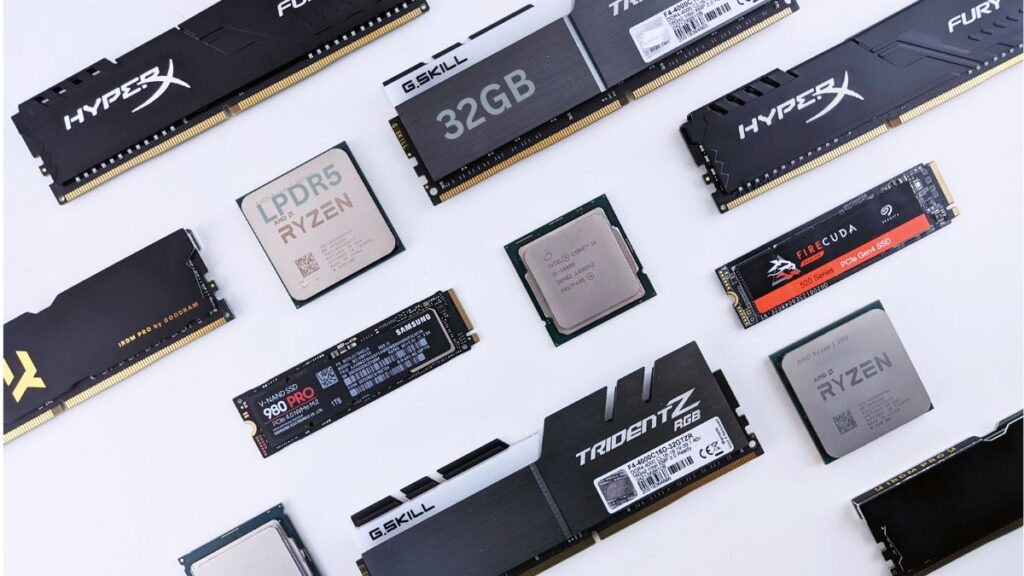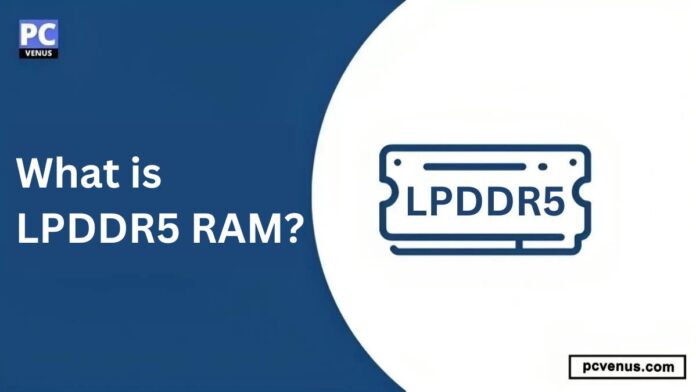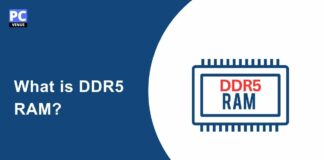Nowadays, Almost all the latest and upcoming devices like smartphones, laptops, etc come with LPDDR5 RAM. Apart from portable devices, it is also being used in cloud computing, autonomous cars, and AR systems.
It offers faster data transfer speeds than all previous generation LPDDR series. New technology has been used to make it, and features like error correction have been made more accurate than before.
Along with good performance, it consumes low power, which is great for portable devices as battery life is important for portable devices like mobile phones and tablets.
The demand for mobile computing is increasing rapidly, and devices have started using new applications, 5G connectivity, and AI tools, which require a good RAM that can perform all these tasks smoothly. LPDDR5 RAM is designed to perform all of these functions.
In this article, we will talk in detail about the performance of this LPDDR5 RAM so that you can know how this performs and for which devices it is useful. We will also discuss its compatibility, energy efficiency, and price.
What is LPDDR5 RAM?

LPDDR5 RAM stands for Low Power Double Data Rate. This is the latest generation of memory used in portable devices like mobiles, laptops, tablets, etc. Its data transfer rate is higher than all previous LPDDR RAM series and also has very low power consumption. Due to its low power consumption, it is widely used in mobile phones, tablets, and portable devices because battery life is important in all these devices.
Advantages of LPDDR5 RAM

Better Data Transfer Rate
LPDDR5 RAM has faster data transfer speeds compared to previous versions. This speedup was achieved by doubling the number of banks in each channel to 8, rather than making it a 32-bit dual-channel architecture like the previous generation LPDDR4 and LPDDR4x, instead returning it to 16-bit channels.
Its maximum data transfer speed is up to about 6400 Mbps, which is much more than its previous LPDDR4X, whose speed was about 4266 Mbps. Due to the high data transfer speed, the app loads quickly, there is no buffering during browsing, and the game runs smoothly.
Better Power Efficiency
LPDDR5 RAM is known for its low power consumption, which is its main benefit. It adjusts power according to how much work it’s doing, which helps save energy. That’s why it’s commonly found in mobile devices like smartphones and tablets because they need to save battery power to last longer.
Enhance Data Integrity
This is a new generation RAM in which new technology has been combined with features like Link ECC (Error Correction Code) and On-die ECC, which checks the data to see if there is any error before sending it to the CPU. Corrects it and then sends that data to the CPU.
Due to its error correction feature, the reliability and integrity of the data have increased. Also, with this new feature, the data processed by the device has become accurate, and the possibility of data corruption has also been reduced.
Low Latency
Advanced technology has been used to make it, due to which its working speed has become very high. It takes much less time to complete a task compared to LPDDR4X.
To perform any work, it reads the data quickly and immediately sends the data to the CPU so that the work gets done quickly. This increases the overall speed and response of the system by allowing it to perform any task faster. Its low latency makes it easier to perform tasks that require quick data access and processing.
Feature Proofing
The best thing about this RAM is that it is future-proofing. As the demands of mobile applications and operating systems are increasing these days, LPDDR5 RAM provides a more future-proof solution with its higher bandwidth and efficiency. Because of this future-proofing capability, it can handle not only current software demands but also future updates and applications. This RAM is likely to have no problem adjusting to future devices.
Also Read:
LPDDR5 vs LPDDR5X vs DDR5 vs LPDDR4 vs LPDDR3, LPDDR2 vs LPDDR1
| Feature | LPDDR5 | LPDDR5X | DDR5 | LPDDR4 | LPDDR3 | LPDDR2 | LPDDR1 |
|---|---|---|---|---|---|---|---|
| Purpose | Mobile devices, ultrabooks, low-power systems | Mobile devices, ultrabooks, low-power systems | Desktops, high-end laptops, servers | Mobile devices, ultrabooks, low-power systems | Mobile devices, ultrabooks, low-power systems | Mobile devices, ultrabooks, low-power systems | Mobile devices, ultrabooks, low-power systems |
| Data Rate | Up to 6400 Mbps (standard) | Up to 8533 Mbps (LPDDR5X) | Up to 8400 Mbps (standard) | Up to 4266 Mbps (LPDDR4X) | Up to 2133 Mbps | Up to 1066 Mbps | Up to 400 Mbps |
| Bandwidth | Up to 51.2 GB/s | Up to 68.2 GB/s | Up to 67.2 GB/s | Up to 34.1 GB/s (LPDDR4X) | Up to 17 GB/s | Up to 8.5 GB/s | Up to 3.2 GB/s |
| Operating Frequency | Up to 3200 MHz | Up to 3200 MHz | Up to 4800 MHz | Up to 2133 MHz (LPDDR4X) | Up to 1066 MHz | Up to 533 MHz | Up to 200 MHz |
| Voltage Modes | Dual voltage (1.05V & 0.5V) with dynamic scaling | Dual voltage (1.05V & 0.5V) with dynamic scaling | Single voltage (1.1V) | Single voltage (1.1V) | Single voltage (1.35V) | Single voltage (1.8V) | Single voltage (2.5V) |
| Channels | 2x 16-bit channels | 2x 16-bit channels | 2x 32-bit channels (per DIMM) | 2x 32-bit channels | 2x 64-bit channels | 2x 64-bit channels | 2x 64-bit channels |
| Burst Length | 16 (per channel) | 16 (per channel) | 16 (per channel) | 16 (per channel) | 8 (per channel) | 4 (per channel) | 2 (per channel) |
| Prefetch | 16n (per channel) | 16n (per channel) | 16n (per channel) | 16n (per channel) | 8n (per channel) | 4n (per channel) | 2n (per channel) |
| Banks | Flexible (4, 8, or 16 banks) | Flexible (4, 8, or 16 banks) | 32 (complex bank structure) | 8 (standard bank structure) | 8 (standard bank structure) | 4 (standard bank structure) | 4 (standard bank structure) |
| Memory Densities | Up to 32GB per channel | Up to 32GB per channel | Up to 64GB | Up to 16GB per channel | Up to 8GB per channel | Up to 4GB per channel | Up to 2GB per channel |
| Error Correction | On-die ECC | On-die ECC | External ECC chip or integrated in memory controller | On-die ECC | On-die ECC | On-die ECC | No ECC |
| Form Factor | Smaller form factor, typically BGA packages | Smaller form factor, typically BGA packages | Larger DIMM modules | Smaller form factor, typically BGA packages | DIMM modules | DIMM modules | DIMM modules |
| Release Date | February 2019 (standard release) / mid-2019 (mass production) | February 2019 (standard release) / mid-2019 (mass production) | October 6, 2020 | September 2014 | June 2007 | August 2003 | June 2000 |
What to consider when choosing LPDDR5 RAM?

Capacity
Most of the mobile and tablet devices do not have the option of RAM upgrade. If you buy it once, you cannot upgrade it in the future; that is why, first of all, you should identify your requirements and how much RAM you need. Choose the capacity of RAM only based on your usage.
If you only use it for daily tasks and if you do any work, then 6GB to 12GB of RAM will be enough for you. If you do gaming on your device, then up to 16 GB RAM will be suitable for you.
Speed
When you’re buying RAM, make sure to focus on its speed. A faster RAM means better performance for your device. LPDDR5 RAM is especially good in this regard, offering faster speeds than older versions. Keep an eye out for LPDDR5 RAM with higher clock speeds for the best performance.
Compatibility
Check whether that RAM is compatible with the motherboard of your device or not because LPDDR5 RAM is not compatible with all motherboards. Mobile devices often have limited options for RAM upgrades, so compatibility is important. If your device’s motherboard is not compatible with LPDDR5 RAM, you will not realize the full potential of LPDDR5 RAM.
Power Efficiency
It is important to ensure that your device’s battery lasts for a long time. So it is important to choose RAM that helps in power efficiency. LPDDR5 RAM is designed to be energy-efficient, and perfect for mobile devices. Just remember, LPDDR5 RAM comes in different types, choose the one that strikes the right balance between performance and battery life for you.
Brand and Quality
In today’s market, numerous companies are producing RAM, but not all of them deliver top-notch quality. That’s why it’s important to consider the brand when purchasing RAM. Reputable companies prioritize using high-quality materials in their RAM production, ensuring both reliability and performance. Brands like Kingston, Samsung, Everspin, and Micron are known for manufacturing superior-quality LPDDR5 RAM.
Budget
Be it RAM or anything else, take special care of your budget. If your budget is low and you only do daily tasks, then buying LPDDR5 RAM can be expensive. If you do gaming or intensive tasks, then you should choose LPDDR5 RAM. LPDDR5 RAM is a little more costly than other RAMs, so invest only with your needs in mind.

FAQs
LPDDR5 RAM stands for Low Power Double Data Rate 5 Random Access Memory. It is a type of memory technology designed for mobile devices, ultrabooks, and other power-efficient computing systems.
No, LPDDR5 RAM is not backward compatible with LPDDR4. The two generations use different interfaces and signaling standards, so LPDDR5 memory modules cannot be used in devices designed for LPDDR4.
LPDDR5 RAM offers many benefits, including faster data transfer rates, better power efficiency, and better overall performance for devices. This enables smoother multitasking, faster app loading times, and a better gaming experience on smartphones, tablets, and other portable devices.
LPDDR5 RAM is usually soldered to the device’s motherboard and cannot be upgraded or replaced by the end user. It is essential to select the desired amount of RAM while purchasing the device as it cannot be changed later.
LPDDR5X is an upgraded version of LPDDR5, offering higher data rates (up to 8533 Mbps) and improved bandwidth.
While both LPDDR5 and LPDDR5X are energy-efficient, LPDDR5X excels in speed.
Final Word
LPDDR5 RAM is good in almost all areas. Along with performance, it also contributes to prolonging the battery life of the device. Its speed is more than all the previous generation RAMs, but its price is also higher.
The price of all the devices that come with this RAM is high. This RAM is not compatible with its previous generation, LPDDR4/3/2; this means that while buying this RAM, you have to check its compatibility with your motherboard and whether it is compatible with your motherboard or not.
Devices like mobile phones and tablets that come with LPDDR5 RAM have better performance and battery life. Due to its future-proofing, it is not likely to have any problem adjusting to future devices.
References




